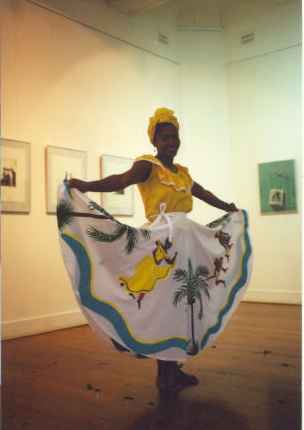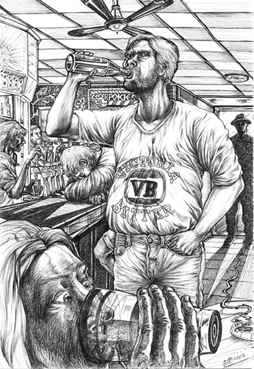Home | Vol 13 Table of Contents | Previous Issues | Contact Us: 07 55278753 / 0405463663 | Email: judybyronbay@yahoo.com
Ali's Page
Ali Crosby came to Byron Bay from UTS in Sydney, for a one week placement to work with AIAA. During that time she produced some excellent work for Inspirasi, including articles, photography and translations Her email is: alicrosby@hotmail.com
The Refugee Experience

On Monday, October 28th, as part of National Refugee month, an exhibition
of work by artists from the Woomera detention centre was opened at the
Lismore Regional Art gallery.
AIAA members attended the opening ceremonies which were organised by Centrelink and the Community Settlement Service in Lismore.
Each person was given a grain of rice and
a blade of grass as they entered the gallery, symbolising the hope of
new life experienced by newcomers to Australian shores. Following a traditional
welcome by Bunjalung Elders, the audience enjoyed a range of performances
from around the world.
The 'Silken Thread' Theatre Group made their touching debut with a piece
about the life of a local Migrant woman and her journey from Vietnam.

Maha Krayem Abdo, the President of the NSW Muslim Women's Association spoke eloquently about the complexity of life and culture that refugees have woven into the tapestry of Australian life. 'There is no way to Peace, but Peace is the way,' she said after the group had shared a moment of silence to grieve the lives lost in the struggle for peace, and for the refugees who have lost their lives on their journeys to escape oppression in their own countries.
Amongst the performers that followed, was the energetic dancer Rina Sani,
from the theatre group Orisha. As an expression of traditional and modern
cultural fusion, Rina has recently introduced Chinese elements to her
Indonesian choreography.
The day was a huge success, celebrating the strengths of cultural diversity
in the Lismore community and confronting some of the misperceptions in
Australian society.
As part of the program Maha also gave led a Forum on Tuesday entitled " The Truth Behind the Veil: Demystifying Islam" aimed at educating the community and in particular community workers about Islam.
Troppo Obscura
Presented by Carnivale & International Studies, University of Technology Sydney.
By Ali Crosby
Email alicrosby@hotmail.com
As part of the Carnivale Festival in Sydney during October, Monika Wulff
introduced Sydney to some of the complexities of Australia-Indonesia relations
with her multimedia installation and performance Troppo Obscura.
Monika used five oversized cameras, combined with archival film footage,
video installation, and live dancing to involve the viewer in an exploration
of the cultural impacts of colonialism. Each camera portrayed different
aspects of cultural identity, illustrating their contradictions and exposing
their stereotypes. One offered a 'peepshow' onto the stomach of performer
Teik-Kim Pok, upon which a bikini-clad woman danced seductively. Another
depicted the sexual relationships between Indonesian men and Australian
women, juxtaposing an intimate conversation between friends with historical
images of Javanese men.
Monika's piece was both brave and emotional, as well as extremely well-researched.
Her aim to "(re)imagine the human subject and create new spaces where
all can exist authentically and be represented" may seem overly ambitious,
but the flexibility of her approach including, strong collaboration with
other amazing artists including Yogyakarta-based sculptor Hedi Hariyonto,
made Troppo Obscura a huge success.

 Aris
began making art in Indonesia during Suharto's New Order Regime, at
a time when violence, corruption, and censorship were common place.
While many Indonesians were trying to survive by ignoring the realities
of their military government, Aris felt he had no choice but to draw
the oppression he felt and saw. The methods of representing both the
reality of society and the nightmares of his subconscious are an ongoing
learning process that Aris says is 'the pillar of strength' he needs
to face the problems of reality.
Aris
began making art in Indonesia during Suharto's New Order Regime, at
a time when violence, corruption, and censorship were common place.
While many Indonesians were trying to survive by ignoring the realities
of their military government, Aris felt he had no choice but to draw
the oppression he felt and saw. The methods of representing both the
reality of society and the nightmares of his subconscious are an ongoing
learning process that Aris says is 'the pillar of strength' he needs
to face the problems of reality.